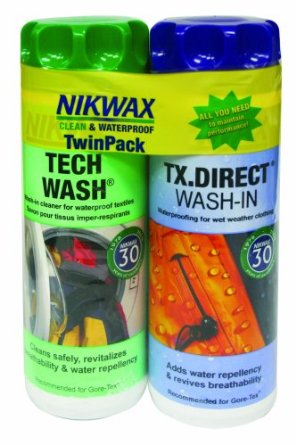Is there a way to tie dye a tent?
Name: Bill
—ADVERTISEMENTS—
Refresh and restore DWR water-repellent finishes on outdoor gear

DWR finishes are incompatible with dyeing. DWR finishes should be applied only after dyeing is completed.
Country or region: USA
Message: Is there a way to tie dye a tent? Thank you.
You can't dye or paint any commercially-available tent, because the DWR (durable water resistant) coating will prevent any dye or paint from reaching the actual fibers. Water beads up on the surface, and so will water-based liquids such as dyes and fabric paints.
However, you can have a tie-dyed tent! What you will need to do is to buy some untreated thin fabric and use the fly from a tent as a pattern to construct your own non-water-resistant tent fly, which you can waterproof after dyeing. (If you're not familiar with modern tent construction, the fly is a separate piece that attaches to the top of a tent to provide protection against rain.) Use your tie-dyed tent fly in place of the one that was sold with the tent; the overall effect will be of a tie-dyed tent, since the fly is by far the most visible part of your tent. Alternatively, you could make a very simple rectangular tent fly, staked at each corner, with a pole and guy line at each end, to mount over your tent. Choose the color of the main structure of your tent so that it will go with your tie-dyed fly.
You will have to test-dye a small snippet of the fabric you choose for your new tent fly, to make sure that it will accept the dye or fabric paint, before you begin to sew. Ask your fabric supplier to give or sell you a small swatch of each of their likely fabrics for this purpose. Be sure to tell them that you want untreated fabric, not water-resistant fabric. If necessary, test the fabric by sprinkling a few drops of water on it, to make sure that they soak in immediately, instead of beading up; don't even try to dye a fabric that is water-resistant. If you don't have a local source for a suitable material, try one online, such as a silk or nylon fabric from Dharma Trading Company, or a non-water-resistant ripstop nylon from The Rain Shed, if they sell one that is not treated. The Rain Shed sells other parts that you may need, as well, including webbing, hooks, and zippers.
Try to find material that is labeled as PFD ("Prepared For Dyeing") or PFP ("Prepared For Printing"), which lack surface finishes that will interfere with dyeing. Dharma's nylon PFD fabric is guaranteed to be dyeable, so it's an excellent choice; nylon from other sources often has invisible treatments that interfere with dye. In addition, pre-wash your material before beginning dyeing, using very hot water, Synthrapol detergent, and extra soda ash to try to remove any remaining fabric sizings or finishes.
Once you have constructed your new non-water-resistant tent fly, or perhaps working with the fabric before constructing the fly from it, you can tie-dye it. You will have to choose your dyes and methods according to the fiber content of the fabric you chose for your fly. Silk is extremely easy to dye with many different types of dye, including an ordinary tie-dyeing kit such as the excellent ones made by Jacquard Products, but it is less durable. Nylon can be dyed with a type of dye called acid dye; it requires heat to set it, which can be arranged by steaming the fabric, in a way similar to steaming vegetables, after applying the dye and letting it dry. Polyester is more difficult to dye and requires disperse dyes, but there are a couple of very different methods for applying it. A good thin fabric paint is another alternative for tie-dyeing untreated nylon or polyester. Avoid non-dyeable fabrics such as polypropylene or polyester/spandex blends.
After you have completely finished dyeing your tent fly, you will need to apply a durable water repellent finish. You can find this type of product from a supplier for camping or mountaineering, since DWR finishes on tents and outdoor clothing tend to wear off and must be replenished at least once every ten years. My first choice would be Nikwax TX-Direct Wash-In, which can be applied in a washing machine; I think the wash-in product is more suitable as the first waterproofing treatment for a new item that has not been waterproofed before. Spray-on DWR finishes are also available.
(Please help support this web site. Thank you.)
(Please help support this web site. Thank you.)
Posted: Tuesday - May 29, 2012 at 07:50 AM
Follow this blog on twitter here.
Quick Links
- All About Dyes & Dyeing Top -
- Top of this blog -
- FAQ -
- The Dye Forum -
- How to Tie Dye - How to Batik -
- Books - Toys - Plants -
- Top of this blog -
- FAQ -
- The Dye Forum -
- How to Tie Dye - How to Batik -
- Books - Toys - Plants -
More in this category:
- -
Statistics
Total entries in this blog:
Total entries in this category:
Published On: Aug 29, 2012 02:49 PM
Total entries in this category:
Published On: Aug 29, 2012 02:49 PM